 This article first appeared in the August 2013 issue of Shape magazine. We have reproduced it for the information of those of you who missed it when it was published. Dr Ho Kok Sen was one of the panel of experts to discuss on a few dental related issues. Dr Ho shared more information on Missing Teeth options.
This article first appeared in the August 2013 issue of Shape magazine. We have reproduced it for the information of those of you who missed it when it was published. Dr Ho Kok Sen was one of the panel of experts to discuss on a few dental related issues. Dr Ho shared more information on Missing Teeth options.
Problem: Missing Teeth
In a 2012 pan-European survey on oral health conducted by Glaxosmithkline (GSK) and Wrigley, 42 per cent of Irish adults were found to have missing teeth. In another survey of 3,742 American residents, the US Centers for Disease Control and Prevention found that close to 50 per cent of adults had lost at least one tooth.
Dr Ho Kok Sen, an oral and maxillofacial surgeon with Specialist Dental Group, explains that tooth extraction or loss could be due to gross dental caries, root canal complications or teeth fractures due to trauma. Bruxism or nocturnal involuntary clenching-grinding of the teeth can also cause teeth to become severely worn down, resulting in their weakening and a higher risk of damage.
TREATMENT DENTURES OR DENTAL IMPLANTS
Dentures are removable and a quick, relatively economical method of filling gaps – even if you’re missing just one tooth. Those with dentures need to see their dentist every two years to have them relined.
Dr Ho says that some wearers experience discomfort as dentures are made to fit over gums and do not feel real. What’s more, your gums and jawbone will eventually shrink and the dentures may not fit as well as they used to and become loose, or they may become worn.
Other reasons for a poor fit: when the jaw bone resorbs or teeth affected by periodontal disease start to move. If such dentures are not replaced, they can cause great discomfort and lead to mouth sores, infections or problems with eating and speech.
As for dental implants, the American Academy of Periodontology defines these as artificial tooth roots (through screws, cylinders or blades) that are placed in the jaw to hold a replacement tooth or bridge.
According to Dr Ho, dental implants are considered the gold standard in teeth replacement for their natural appearance and function. They don’t have to be removed and the bite force is similar to normal teeth so patients can chew better. When inserted into the jaw bones, the implants also help to support gum tissue (which tends to recede when teeth fall out because of bone loss) and maintain a more youthful profile.
The treatment spans three to four months to allow for healing and integration of an implant with the jaw bone. Meanwhile, an impression made by the specialist is used to fabricate crowns that will be attached to the implants after the healing period. Once done, teeth appear natural and are strong as well as functional.
While dental implants typically have a high success rate of more than 95 per cent, Dr Ho revelas that they are not for patients who have had teeth missing for a long time or traumatic extractions that have led to an inadequate jaw bone for implant placement, or even metabolic bone diseases like osteoporosis or oral cancer. Smokers are also not suitable as nicotine affects blood circulation to the jaw and impairs healing.





